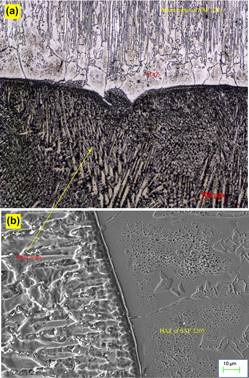Crossref Citations
This article has been cited by the following publications. This list is generated based on data provided by
Crossref.
Ramkumar, K. Devendranath
Kumar, P. Siva Goutham
Krishna, V. Radha
Chandrasekhar, Aditya
Dev, Sidharth
Abraham, Winston Sunny
Prabhakaran, S.
Kalainathan, S.
and
Sridhar, R.
2016.
Influence of laser peening on the tensile strength and impact toughness of dissimilar welds of Inconel 625 and UNS S32205.
Materials Science and Engineering: A,
Vol. 676,
Issue. ,
p.
88.
Verma, Jagesvar
Taiwade, Ravindra V.
and
Sonkusare, Reshma
2017.
Effects of austenitic and duplex electrodes on microstructure, mechanical properties, pitting, and galvanic corrosion resistance of ferritic and dual-phase stainless steel dissimilar joints.
Journal of Materials Research,
Vol. 32,
Issue. 16,
p.
3066.
Hu, XiaoAn
Xue, ZhiYuan
Zhao, GaoLe
Yun, Jiang
Shi, Duoqi
and
Yang, XiaoGuang
2019.
Laser welding of a selective laser melted Ni-base superalloy: Microstructure and high temperature mechanical property.
Materials Science and Engineering: A,
Vol. 745,
Issue. ,
p.
335.
K., Devendranath Ramkumar
Sidharth, Dev
K.V., Phani Prabhakar
R., Rajendran
K., Giri Mugundan
and
S., Narayanan
2019.
Microstructure and properties of inconel 718 and AISI 416 laser welded joints.
Journal of Materials Processing Technology,
Vol. 266,
Issue. ,
p.
52.
Sokkalingam, Rathinavelu
Muthupandi, Veerappan
Sivaprasad, Katakam
and
Prashanth, Konda Gokuldoss
2019.
Dissimilar welding of Al0.1CoCrFeNi high-entropy alloy and AISI304 stainless steel.
Journal of Materials Research,
Vol. 34,
Issue. 15,
p.
2683.
Yangfan, Wang
Xizhang, Chen
and
Chuanchu, Su
2019.
Microstructure and mechanical properties of Inconel 625 fabricated by wire-arc additive manufacturing.
Surface and Coatings Technology,
Vol. 374,
Issue. ,
p.
116.
Shamanian, Morteza
Kangazian, Jalal
Derakhshi, Mohammad Amir
and
Szpunar, Jerzy A.
2019.
Microstructure and Mechanical Properties of Inconel 617/AISI 310 Electron Beam Welds.
Metallurgical and Materials Transactions A,
Vol. 50,
Issue. 7,
p.
3164.
Kısasöz, Alptekin
Tümer, Mustafa
and
Karaaslan, Ahmet
2021.
Microstructure, mechanical and corrosion properties of nickel superalloy weld metal.
Materials Testing,
Vol. 63,
Issue. 10,
p.
895.
Xiao, Lin
Cota-Sanchez, Germán
and
Adams, Frederick Powell
2021.
MICROSTRUCTURAL CHARACTERIZATION AND TENSILE PROPERTIES ASSESSMENT OF GTAW WELDED INCOLOY 800H ALLOYS FUEL CLADDING FOR SCWR.
CNL Nuclear Review,
Vol. 10,
Issue. 1,
p.
20.
P, Roshith
2021.
Enhancement of metallurgical and mechanical properties of the materials by performing CO2laser beam welding.
Welding International,
Vol. 35,
Issue. 1-3,
p.
59.
Maurya, Anup Kumar
Pandey, Chandan
and
Chhibber, Rahul
2021.
Dissimilar welding of duplex stainless steel with Ni alloys: A review.
International Journal of Pressure Vessels and Piping,
Vol. 192,
Issue. ,
p.
104439.
Sarathchandra, DT
and
Davidson, MJ
2021.
Effect of heat input on mechanical and microstructural properties of Inconel 625 depositions processed in wire arc additive manufacturing.
Proceedings of the Institution of Mechanical Engineers, Part E: Journal of Process Mechanical Engineering,
Vol. 235,
Issue. 5,
p.
1439.
Tümer, M.
Mert, T.
and
Karahan, Tuba
2021.
Investigation of microstructure, mechanical, and corrosion behavior of nickel-based alloy 625/duplex stainless steel UNS S32205 dissimilar weldments using ERNiCrMo-3 filler metal.
Welding in the World,
Vol. 65,
Issue. 2,
p.
171.
Jiang, Qi
Zhang, Peilei
Yu, Zhishui
Shi, Haichuan
Li, Shaowei
Wu, Di
Yan, Hua
Ye, Xin
and
Chen, Jieshi
2021.
Microstructure and Mechanical Properties of Thick‐Walled Inconel 625 Alloy Manufactured by Wire Arc Additive Manufacture with Different Torch Paths.
Advanced Engineering Materials,
Vol. 23,
Issue. 1,
Meng, Wei
Lei, Yunlong
Wang, Xing
Ma, Qunshuang
Hu, Lei
Xie, Hu
and
Yin, Xiaohui
2022.
Interface characteristics and mechanical properties of wire-arc depositing Inconel 625 superalloy on ductile cast iron.
Surface and Coatings Technology,
Vol. 440,
Issue. ,
p.
128493.
Hong, Min
Wang, Shanlin
Sun, Wenjun
Geng, Zhijie
Xin, Jijun
and
Ke, Liming
2022.
Effect of welding speed on microstructure and mechanical properties of selective laser melting Inconel 625 alloy laser welded joint.
Journal of Materials Research and Technology,
Vol. 19,
Issue. ,
p.
2093.
Kumar, Amit
Pandey, Shailesh M.
and
Pandey, Chandan
2022.
Dissimilar weldments of ferritic/martensitic grade P92 steel and Inconel 617 alloy: Role of groove geometry on mechanical properties and residual stresses.
Archives of Civil and Mechanical Engineering,
Vol. 23,
Issue. 1,
Maurya, Anup Kumar
Chhibber, Rahul
and
Pandey, Chandan
2023.
GTAW Dissimilar Weldment of sDSS 2507 and Nickel Alloy for Marine Applications: Microstructure–Mechanical Integrity.
Metallurgical and Materials Transactions A,
Vol. 54,
Issue. 8,
p.
3311.
Akash, P
Puviyarasan, M
Senthil, T S
Rathinasuriyan, C
and
Sindhiya, S
2023.
Microstructural characterization and mechanical properties of Inconel 625 wall fabricated by GTAW-based WAAM using stringer bead and circular weave pattern.
Engineering Research Express,
Vol. 5,
Issue. 3,
p.
035020.
Maurya, Anup Kumar
Chhibber, Rahul
and
Pandey, Chandan
2023.
Studies on residual stresses and structural integrity of the dissimilar gas tungsten arc welded joint of sDSS 2507/Inconel 625 for marine application.
Journal of Materials Science,
Vol. 58,
Issue. 20,
p.
8597.





